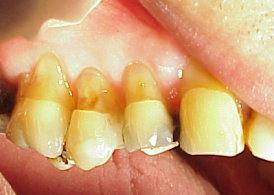 People have mistakenly been given the impression that toothbrushing can damage teeth (notches at the gumline), or cause receding gums. Even a hard toothbrush cannot damage teeth, and toothbrushes today could hardly get any softer.
People have mistakenly been given the impression that toothbrushing can damage teeth (notches at the gumline), or cause receding gums. Even a hard toothbrush cannot damage teeth, and toothbrushes today could hardly get any softer.
An article published years ago very clearly considered the cause for such problems – which is NOT toothbrushing, but people (including many dental professionals) still are under the impression that toothbrushing can damage teeth/gums. For those interested, the article is: “On The Longevity Of Teeth”, Gene McCoy, DDS, Journal of Oral Implantology, 1983, 11(2): 248-67, PMID: 6584638.
Notches at the gumline are called abfractions (Grippo, 1991) and can be found:
- in societies and cultures where no toothbrushes exist,
- they can be found below the gumline – not accessible by a toothbrush, and
- even in teeth of people who don’t brush well.
Abfractions are caused by biting forces on teeth that are excessive for many years (see bite adjustment). Excessive biting force is also one of two main reasons people have receding gums (the other reason is destructive plaque germs and the cascade of destruction they trigger).
The recommended brushing method is and has been side to side. A soft toothbrush is recommended because the critical area to clean is at the gumline, and a soft toothbrush makes it easier to brush a long time at/on the gums; although, today the multilevel toothbrushes clean even more effectively, combining hard, medium and soft bristles in one brush (stiffness of a bristle is a function of diameter and length). All dentists and hygienists agree that the most important factor in effective toothbrushing is how long you brush.
References on Abfractions (PDFs)

